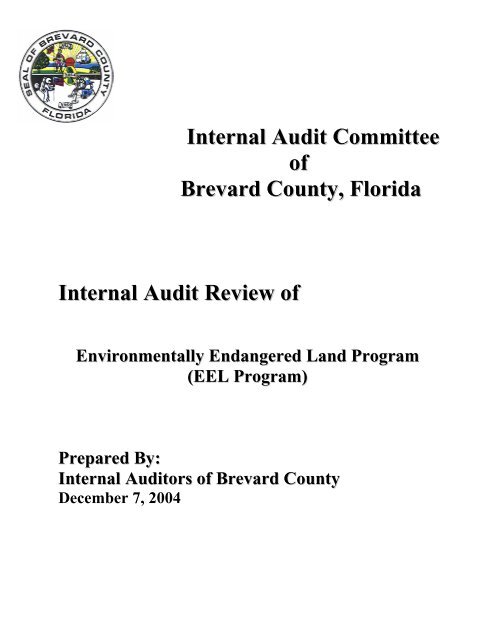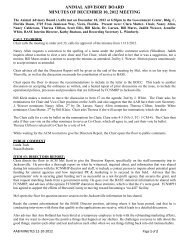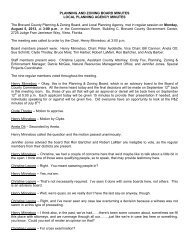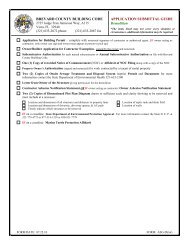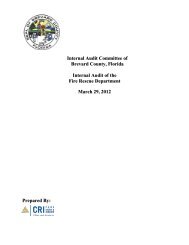EEL Program 12-07-2004 - Brevard County
EEL Program 12-07-2004 - Brevard County
EEL Program 12-07-2004 - Brevard County
- No tags were found...
You also want an ePaper? Increase the reach of your titles
YUMPU automatically turns print PDFs into web optimized ePapers that Google loves.
December 7, <strong>2004</strong>The Audit Committee of<strong>Brevard</strong> <strong>County</strong>, FloridaViera, Florida 32940-6699Pursuant to the provisions of Section <strong>12</strong>5.01(1)(s), Florida Statutes, and the approved 2003/<strong>2004</strong> internal audit plan,we hereby submit our internal audit report covering <strong>EEL</strong>’s <strong>Program</strong>. We will be presenting this report to the Auditcommittee at the next scheduled meeting on April 22, 2005.Our report is organized in the following sections:BackgroundObjectives and ApproachIssues and Recommended ActionsThis provides an overview of <strong>EEL</strong> <strong>Program</strong>.The internal audit objectives and focus areexpanded upon in this section as well as areview of the various phases of our approach.This section gives a description of the issuesas well as the impact and recommendedactions.We would like to thank the Parks and Recreation Department and all those involved in assisting the InternalAuditors regarding this report on the <strong>EEL</strong> <strong>Program</strong>.Respectfully Submitted,INTERNAL AUDITORS1
Background
BackgroundOverviewThe <strong>EEL</strong> (Environmentally Endangered Lands) <strong>Program</strong> was formed in 1990 subsequent to <strong>Brevard</strong> <strong>County</strong>’scitizen vote to tax themselves for the purchase of environmentally endangered lands. The <strong>County</strong> was authorized toissue bonds up to $55 million to support the costs of acquiring, protecting and maintaining these lands.During the November <strong>2004</strong> election, <strong>Brevard</strong> <strong>County</strong> citizens voted to extend the purchasing power of the <strong>EEL</strong><strong>Program</strong> by approving the Land and Water Areas Bond Referendum, which will provide up to $60 million ofadditional funding over the next 20 years.The <strong>EEL</strong> <strong>Program</strong> is dedicated to protecting and maintaining environmentally endangered lands. The <strong>EEL</strong> <strong>Program</strong>is managed and assisted by <strong>Brevard</strong> <strong>County</strong>’s Parks and Recreation Department. The <strong>Program</strong>’s objective is toconserve the natural resources of <strong>Brevard</strong> <strong>County</strong> while providing educational and recreational facilities.StaffingKey personnel from Parks and Recreation involved in the operations of the <strong>EEL</strong> <strong>Program</strong> are as follows:NameCharles NelsonMike KnightLarry WojiechowskiTitleDirector of Parks and RecreationInterim <strong>Program</strong> ManagerParks and Recreation Finance ManagerLand AcquisitionThe <strong>EEL</strong> <strong>Program</strong>'s main purpose is to acquire land which is deemed to be environmentally in danger. Through theefforts of this program, approximately 18,000 acres of land has been preserved. Most of the land acquired by the<strong>Program</strong> was purchased in conjunction with funding from the State of Florida. The <strong>EEL</strong> <strong>Program</strong> also works withother conservation programs to purchase land. Some of the agencies <strong>EEL</strong> partners with include St. John’s RiverWater Management District and the North American Wetlands Conservation Act. Partnering with other agenciesleaves the <strong>Program</strong> more available funding to purchase additional land.The Selection and Management Committee (SMC) is responsible for initially identifying which parcels should betargeted by the <strong>EEL</strong> <strong>Program</strong> for purchase. The SMC is made up of local <strong>Brevard</strong> <strong>County</strong> scientists appointed bythe Board of <strong>County</strong> Commissioners (The Board). Identification of land by the SMC is determined based on thescientific criteria used to conserve particular habitats and species. A list of SMC's “target properties” is presented tothe Board for approval before any action is taken for purchase.The <strong>EEL</strong> <strong>Program</strong> has contracted with the Nature Conservancy (TNC), since the program's inception, to performland acquisition services for the <strong>Program</strong>. TNC is responsible for identifying the land owner and negotiating withthe land owner on a selling price, never to exceed the appraised value. TNC normally discusses with the land ownerhis willingness to sell the property prior to the presentation to the Board of the “target properties” list.Upon approval of the “target list” appraisal requests are sent out to various Florida State Certified Appraisers. Threeresponses to the appraisals are required, two being acceptances. The two lowest bidders are awarded the appraisal.The highest appraisal is then used as the maximum amount permissible for purchase of the targeted land.2
Background (continued)Land ManagementIt is the primary responsibility of <strong>EEL</strong> <strong>Program</strong> staff to manage lands acquired by the <strong>EEL</strong> <strong>Program</strong>. In addition, the<strong>EEL</strong> <strong>Program</strong> is required to manage certain other properties purchased by the State, as defined in the <strong>County</strong>’sManagement Lease Agreements with the State. The <strong>County</strong> has developed a Sanctuary Management Manual toguide <strong>EEL</strong> <strong>Program</strong> staff and to define the <strong>County</strong>’s overall objectives with respect to land management.There are four large management areas within <strong>Brevard</strong> <strong>County</strong>; North, Central, South and South Beach. Eachregion is assigned one land manager who is responsible for implementing the <strong>Program</strong>’s objectives specific to eachregion.Education CentersAn objective of the <strong>EEL</strong> <strong>Program</strong> is to open four public education centers, one located in each of the four regions.Currently the Enchanted Forest Sanctuary is the only Center open.• Enchanted Forest Sanctuary (North Region) - Located in the North Region, the Enchanted ForestSanctuary was purchased for its unique geology and high biological diversity. This center is located on a393 acre parcel of land in Titusville.• Pine Island Conservation Area (Central Area) – The largest of the four centers being 879 acres andadjoining the Merritt Island National Wildlife Refuge, the Pine Island Conservation Area is jointly ownedby the <strong>County</strong> and by the St. John’s River Water Management District.• Malabar Scrub Sanctuary (South Area) – Malabar Scrub Sanctuary spreading out over 395 acre lands inthe south area is a haven for the Florida scrub-jay, gopher tortoise and eastern indigo snake.• Barrier Island Ecosystem Center (South Beaches) - The Barrier Island Ecosystem Center was propertydonated by the Richard King Mellon Foundation. The facility provides educational opportunities with itspreserved barrier island habitats.Outdoor RecreationThe <strong>EEL</strong> <strong>Program</strong> provides for recreation to the public with its twelve sites. The sites offer various amenitiesincluding hiking trails, boardwalks, informational kiosks, and guided tours.3
Objectives and Approach
Objectives and ApproachObjectivesThe internal audit for the <strong>EEL</strong> <strong>Program</strong> includes the following:ApproachDetermine that controls are in place to ensure compliance withapplicable Florida Statutes and the applicable Board of <strong>County</strong>Commissioners’ policies, procedures, resolutions, ordinances andagreements.Determine the <strong>EEL</strong> <strong>Program</strong> has an effective system of controls inplace that operate as designed to monitor contract performance.Determine the <strong>EEL</strong> <strong>Program</strong> maintains effective controls over<strong>County</strong> assets.Determine records and documentation for the various projects aresufficient to establish an audit trail for all transactions involvingdisbursements.Determine invoices are processed and paid in accordance with<strong>County</strong> policies. Identify and assess the effectiveness of accounting andadministrative controls over timekeeping and payroll relatedprocessing.Our audit approach consisted of four phases:Determine the <strong>EEL</strong> <strong>Program</strong> system of internal accounting andadministrative controls operates as designed and provides accuratetimely information while at the same time is an efficient andeffective operation.Understanding and Documentation of ProcessDuring phase one, we held an entrance conference with Charles Nelson, Director, Don Lusk, Assistant <strong>County</strong>Manager, Larry Wojiechowski, Finance Manager, and Mike Knight, Interim <strong>Program</strong> Manager, to discuss the scopeand objectives of the audit work, obtain preliminary data, and establish working arrangements. We then met withother employees of the <strong>EEL</strong> <strong>Program</strong> and documented their roles in the process.Population and Sample DeterminationWe judgmentally selected a sample of land acquisitions completed during the period from September 30, 2002through September 30, <strong>2004</strong>. We also selected samples of employee time entry sheets, various programexpenditures, and written employee evaluations.4
Objectives and Approach (continued)Detailed TestingThe purpose of this phase was development of applicable tests based on our understanding of the <strong>EEL</strong> <strong>Program</strong>.Our procedures included observation and inquiry, walk-throughs, and testing of individual transactions. Our testingincluded, but was not limited to, testing:Land acquisitions<strong>Program</strong> expendituresTime entry<strong>County</strong>’s compliance with State Management Lease Agreements<strong>County</strong>’s compliance with the Conservancy contractConservancy’s compliance with the Conservancy contractDocumentationBid proceduresPurchase order approvalReportingDuring this phase, we summarized our findings related to the <strong>EEL</strong> <strong>Program</strong>, based on our detailed testing, into areport format.5
Issues and Recommended Actions
Issue # 1Insurance Coverage – The NatureConservancy ContractThe <strong>EEL</strong> <strong>Program</strong> has certain unique insurance coverage requirements,based on contracts with various third parties. In particular, we noted thefollowing:According to section 6.01 of the <strong>County</strong>’s contract with The NatureConservancy, the Conservancy is required to maintain certaininsurance coverage at specified limits. Policies are required to coverboth the Conservancy and the <strong>County</strong>. Required coverage includesgeneral and professional liability, automobile, and workers’compensation insurance. The Conservancy is required to furnish tothe <strong>County</strong> certificates of insurance as proof of coverage.According to section 13 of each of the <strong>County</strong>’s Management LeaseAgreements with the State, the <strong>County</strong> is required to maintaincertain insurance coverage at specified limits. Policies are requiredto cover both the <strong>County</strong> and the State. Required coverage includesfire, extended risk and general liability insurance. The <strong>County</strong> isrequired to furnish to the State certificates of insurance as proof ofcoverage on an annual basis.During fieldwork, neither <strong>EEL</strong> <strong>Program</strong> management nor the RiskManagement Department was able to provide updated certificates ofinsurance on either of the contracts mentioned above.With respect to the <strong>County</strong>’s contract with the Conservancy, there was noevidence of effective procedures in place to monitor the Conservancy’scompliance with its requirements. <strong>EEL</strong> <strong>Program</strong> employees had on-handonly one certificate of insurance, which expired July 1, 2003.With respect to the <strong>County</strong>’s Management Lease Agreements with the State,there was no evidence of effective procedures in place to monitor the<strong>County</strong>’s compliance with its requirement to provide the State with annualcertificates of insurance. The specific insurance requirements were notincluded in the Purchasing Department’s contract database, managed by thecontracts division.ImpactWithout adequate monitoring of the Conservancy’s compliance, the <strong>County</strong>cannot be assured the Conservancy has adequate insurance coverage.Ultimately, the <strong>County</strong> may be unnecessarily liable for claims made againstthe Conservancy, while acting on behalf of the <strong>County</strong>.The <strong>County</strong> is not in compliance with its Management Lease Agreementswith the State.6
Issue # 1Insurance Coverage – The NatureConservancy Contract (continued)Recommended ActionWe recommend development of written procedures to annually monitorcompliance with the insurance requirements for all contracts entered into bythe <strong>EEL</strong> <strong>Program</strong>.Procedures should include creation of a checklist to be completed annually.The checklist should be reviewed by the <strong>Program</strong> Manager and retained witha copy of the certificate of insurance.Management Response and Action PlanResponse <strong>EEL</strong> Staff confirmed that the insurance coverages had never lapsed, andcurrent certificates have been provided to the State by <strong>EEL</strong> and to <strong>EEL</strong> fromthe Nature Conservancy. <strong>EEL</strong> Staff will maintain a database that providesoverview information for each contract. This database will include fields forthings that need to be tracked during the course of the ongoing contract thatare not typically tracked by the <strong>County</strong> contract’s administration process.Time Frame The required procedures will be implemented by May 31, 2005.Person Responsible <strong>EEL</strong> <strong>Program</strong> Manager7
Issue # 2Monitoring of The NatureConservancy ContractUnder the <strong>County</strong>’s contract with The Nature Conservancy, the Conservancyprovides certain services related to land acquisition and negotiations of landsales.For its services, the Conservancy earns a set contract fee, paid in equalquarterly installments by the <strong>County</strong>. Section 1.04 of the contract states thatthe Conservancy is required to provide a quarterly accounting of the contractfee (expenses actually incurred by the Conservancy versus contract fee paidby the <strong>County</strong>). We analyzed this accounting over the past four years, fromJanuary 1, 2001 to September 30, <strong>2004</strong>, noting the following results:During 2001, actual expenses incurred by the Conservancyexceeded fees paid by the <strong>County</strong> by $1,341.During 2002, fees paid by the <strong>County</strong> exceeded actual expensesincurred by the Conservancy by $42,119.During 2003, fees paid by the <strong>County</strong> exceeded actual expensesincurred by the Conservancy by $2,243.During <strong>2004</strong> (through first three quarters), fees paid by the <strong>County</strong>exceeded actual expenses incurred by the Conservancy by $64,352.In summary, from January 1, 2001 to September 30, <strong>2004</strong> the <strong>County</strong> paid$686,677 for actual services of $579,304, representing an effectiveoverpayment of $1<strong>07</strong>,373. While a copy of the Conservancy’s accounting ofthe contract fee is attached to each quarterly invoice to the <strong>County</strong>, no onewithin the <strong>EEL</strong> <strong>Program</strong> was aware of the above trend. Further, no one inmanagement monitors this information on a quarterly or annual basis.In addition, section 2.02 of the contract states that the <strong>County</strong> is to performquarterly written evaluations of the Conservancy regarding progressevaluation and overall contributions to <strong>EEL</strong> <strong>Program</strong> objectives. Our testwork indicated that no quarterly evaluations have been performed sinceDecember 31, 2003.ImpactFrom January 1, 2001 through September 30, <strong>2004</strong>, it appears the <strong>County</strong>has paid more than the actual costs incurred for services rendered by TheNature Conservancy. Further, there is no evidence that management ismonitoring the cost benefit relationship of the <strong>County</strong>’s contract with theConservancy.The <strong>County</strong> is not in compliance with section 2.02 of its contract with theConservancy, which requires the <strong>County</strong> perform quarterly writtenevaluations of the Conservancy’s performance.Recommended ActionWe recommend the <strong>County</strong> develop procedures to monitor the cost benefitrelationship of its contract with the Conservancy. Ultimately, the <strong>County</strong>should perform a detailed analysis of the current contract fee based on thecurrent and anticipated future needs of the <strong>County</strong>.8
Issue # 2Monitoring of The NatureConservancy Contract (continued)Recommended Action-continuedWe recommend the <strong>County</strong> comply with section 2.02 of its contract with theConservancy, which requires the <strong>County</strong> perform quarterly writtenevaluations of the Conservancy’s performance.Management Response and Action PlanResponse The Nature Conservancy entered into a fixed fee agreement based on a goodfaith estimate as to the overall costs associated with the service they wouldprovide to the <strong>County</strong>. The documented Conservancy’s expenses were96.4% of Contract income from Contract commencement in 1993 through itstermination December 7, <strong>2004</strong>.Please note that staff is aware that The Nature Conservancy has providedacquisition services that were not billed. For example, during the acquisitionof the Mullett Creek Islands between July and October of 2000, TNCincurred over $10,000 in expenses on behalf of the <strong>County</strong> that was notcharged to the contract. Additional expenses were incurred when TNCassisted in the acquisition of the Inlet Groves Indian River Lagoon Bluewayssite. As a result of their participation, the Department was able to secure a62 acre site for the South Beaches Community Park.This payment process contained in this contract will be reviewed with the<strong>County</strong> Attorney’s office and appropriate modifications incorporated into thecontract(s) to be approved by the Board for future acquisition services. Inaddition, Staff will seek a <strong>County</strong> Attorney’s review of the previousagreement with the Nature Conservancy to determine how the differentialdiscovered as part of this audit is to be addressed. Staff has providedwritten notification to the Nature Conservancy of this finding.Due to the recent departure of the <strong>Program</strong> Manager, the Interim <strong>Program</strong>Manager was not initially aware of the procedure related to quarterlyevaluations of the Nature Conservancy contract. All quarterly evaluationshad been completed up until the time that the previous <strong>Program</strong> Managerresigned.Time Frame The required procedures will be implemented by June 30, 2005Person Responsible <strong>EEL</strong> <strong>Program</strong> Manager9
Issue # 3Sanctuary Management ManualThe <strong>EEL</strong> <strong>Program</strong> maintains a Sanctuary Management Manual (SMM),which provides general guidelines as to how program lands are to bemanaged. The SMM was originally developed by the Selection andManagement Committee (SMC), and was last updated in 1997. The SMMhas been bound and distributed to appropriate <strong>EEL</strong> <strong>Program</strong> employees, andis also posted online to provide public access. We reviewed the SMM, notingthe following inconsistencies between the SMM and actual practice:Section 4.3.5 of the SMM indicates the <strong>County</strong> will establish aCitizens Advisory Committee (CAC) to serve as a liaison betweenthe <strong>EEL</strong> <strong>Program</strong>, local communities and <strong>County</strong> citizens.Members of the CAC are to be appointed by the Board of <strong>County</strong>Commissioners. As of November <strong>2004</strong> a CAC had not beenestablished.Appendix A-1 of the SMM outlines the “<strong>EEL</strong> <strong>Program</strong>Conservation Principles and Directives.” Principle 10 indicates thatmanagement will develop and present to the Board of <strong>County</strong>Commissioners a long-term financial plan. The plan shall bedesigned to allow the <strong>EEL</strong> <strong>Program</strong> to be economically selfsufficient,and shall decrease the future need for increased taxesabove and beyond the 1990 <strong>EEL</strong> Referendum. As of November<strong>2004</strong> management has not developed a long-term financial plan asdescribed above.ImpactThe <strong>County</strong> has not established a Citizen Advisory Committee and istherefore out of compliance with the SMM. Such noncompliance indicatesthe link between the SMC and the public, as intended in the SMM, is notpresent.The <strong>County</strong> has not developed a long-term financial plan and is therefore notin compliance with the SMM. Such noncompliance could result in the <strong>EEL</strong><strong>Program</strong> not being able to become self-sufficient, as intended in the SMM.Recommended ActionWe recommend that management either establish a Citizen AdvisoryCommittee, as described in the SMM, or remove the requirement from theSMM.We recommend that management either develop and present to the Board of<strong>County</strong> Commissioners a long-term financial plan, as described in the SMM,or remove the requirement from the SMM.Management Response and Action PlanResponseStaff had initiated plans to restructure the Citizens Advisory Committee(CAC) prior to the audit. Amendment of the manual and establishment of theCAC had been on hold pending the outcome of the <strong>EEL</strong> referendum. Sincethe audit fieldwork, the Board of <strong>County</strong> Commissioners has approved(March 8, 2005) by resolution #05-053, a committee now called the <strong>EEL</strong>Recreation and Education Advisory Committee. The Commissioners arecurrently completing appointments to this committee.10
Issue # 3Sanctuary Management Manual(continued)Management Response and Action Plan-continuedIn November <strong>2004</strong> voters approved an <strong>EEL</strong> referendum that will provideacquisition and management funds through the year 2025. The <strong>EEL</strong> policymanuals will be revised to reflect the <strong>2004</strong> referendum and modifications tothe Citizen Advisory CommitteeTime Frame The required procedures will be implemented by October 30, 2005Person Responsible <strong>EEL</strong> <strong>Program</strong> Manager11
Issue # 4Land Acquisition ProceduresOne of the <strong>EEL</strong> <strong>Program</strong>’s primary functions is to purchase land. The<strong>County</strong> is responsible to perform certain portions of the land acquisitionprocess, such as land identification, land appraisal, etc. The <strong>County</strong> hascontracted with The Nature Conservancy (TNC) to perform other portions ofthe land acquisition process, such as certain due diligence activities, contractnegotiations, etc.We developed an understanding of the <strong>County</strong>’s process through discussionswith management and TNC representatives, and review of the LandAcquisition Manual (LAM) and the TNC contract. Section 2.03 of the TNCcontract indicates the <strong>County</strong> is responsible for managing the appraisalprocess, including establishment of appraisal assumptions, solicitation ofbids, confirmation of bid acceptance, and appraisal review. As indicated by<strong>EEL</strong> <strong>Program</strong> management, TNC typically provides the <strong>County</strong> with a list of5 or 6 appraisers to be sent a bid request letter.We selected 10 purchases completed in the last two years for testingpurposes, and noted the following three exceptions:In one instance, TNC solicited appraisal bids (on the <strong>County</strong>’sbehalf). Letters were written on TNC letterhead, which gives theappearance that TNC is at times responsible for managing theappraisal process instead of the <strong>County</strong>.Related to another purchase, <strong>EEL</strong> <strong>Program</strong> management was unableto produce a copy of one of the two winning appraisal bids.Accordingly, we were unable to verify that the appraisal wasawarded to the two lowest bidders.Finally, one of the two winning bidders for the purchase of land fromthe National Heritage Foundation submitted their faxed bid on theJuly 5, 2001 deadline. However, the faxed bid did not include anactual dollar amount. Only the hard-copy (delivered the followingday) included the dollar amount.We also noted the LAM provides only vague guidance as to land acquisitionprocedures, focusing more on the intentions of the program rather thandetailed procedures. The TNC contract provides primarily an indication ofthe responsible party for each activity, rather than detailed procedures.ImpactWithout detailed procedures, critical steps could be overlooked in the landacquisition process. Without detailed procedures, turnover of key personnelcould result in disruption of operations, and non-compliance with <strong>County</strong>policies.TNC and <strong>County</strong> responsibilities should be clearly defined in theproceedings to alleviate any potential conflicts of interest.<strong>12</strong>
Issue # 4Land Acquisition Procedures(continued)Recommended ActionWe recommend that <strong>EEL</strong> <strong>Program</strong> management develop detailed landacquisition procedures. Specifically, procedures should indicate changes inresponsibilities depending on whether or not State funds are anticipated. Theprocedures should also clearly state that the <strong>County</strong> is to maintain completecontrol of the appraisal process – in fact and appearance – whenever <strong>County</strong>property taxes may be used to purchase land. In particular, the <strong>County</strong>should be responsible to identify prospective State certified appraisers. Theseprocedures, once adopted, will also assist with training new employees.We recommend development of a standard ‘bid tabulation sheet’ to becompleted by an <strong>EEL</strong> <strong>Program</strong> employee during every appraisal bid process.The tabulation sheet should be reviewed and signed of by the <strong>Program</strong>Manager and retained in the purchase file.Management Response and Action PlanResponse As discussed as part of the audit process, TNC was merely performing theadministrative task of forwarding the <strong>County</strong>’s solicitation to the appropriateappraisers. In an effort to prevent this from occurring in the future, staff willidentify a procedure that ensures all appraisal bid requests, and notices toproceed are distributed on <strong>County</strong> <strong>EEL</strong> Letterhead.Staff was unable to locate a copy of the missing appraisal bid from theappraiser's office. Staff is developing a land acquisition database that will betied to the hard-copy files, which will provide an additional opportunity forfile reconciliation.Due to the significant number of acquisition processes to be followed, thedepartment will be requesting a Land Acquisition Coordinator position beapproved. In addition, staff will be developing a land acquisition proceduralmanual to document specific procedures that are not covered in the <strong>EEL</strong>Land Acquisition Manual. This new manual will be included in the trainingfor new employees.Time Frame The required procedures will be implemented by October 30, 2005.Person Responsible <strong>EEL</strong> <strong>Program</strong> Manager13
Issue # 5Land ManagementThe <strong>County</strong> has a spreadsheet currently maintained by <strong>EEL</strong> <strong>Program</strong>management to track the status of all properties managed under the <strong>EEL</strong><strong>Program</strong>. However, the spreadsheet has not been updated for activity sincethe <strong>Program</strong> Manager left. We also noted the spreadsheet does not identifyproperties by their tax ID number, does not track due diligence costs byacquisition, does not include A-list properties obtained by the State andmanaged by the <strong>County</strong>, includes incomplete or missing data, and does nottrack the status of required Management Plans, all of which would allow formore effective tracking.Appendix A-1 of the SMM outlines the “<strong>EEL</strong> <strong>Program</strong> ConservationPrinciples and Directives.” Principle 10 indicates that management willdevelop and present to the Board of <strong>County</strong> Commissioners an InterimManagement Plan within 90 days and a Management Plan within one year ofthe acquisition of a management unit or sanctuary site.In addition, the <strong>County</strong> manages numerous properties under twoManagement Lease Agreements with the State. For each of these properties,management is also required to submit a Management Plan to the Division ofState Lands, in accordance with subsection 18-2.021(4) of the FloridaAdministrative Code.Our test work indicated that management does not typically develop interimmanagement plans. In addition, numerous properties do not have acompleted and approved Management Plan, in accordance with the aboverequirements. Due to the lack of a comprehensive property tracking tool, itwas not feasible to develop a complete listing of properties not incompliance. However, we noted the following properties lacked a requiredManagement Plan: Continental Acreage (acquired November 2001) TiCo Scrub/TiCo Spaceport (acquired April 1994) Washburn Cove (acquired October 1997)ImpactA more comprehensive tracking system would benefit the <strong>EEL</strong> <strong>Program</strong>.Management is currently out of compliance with its SMM, its ManagementLease Agreements with the State, and subsection 18-2.021(4) of the FloridaAdministrative Code.Recommended ActionWe recommend management update and reorganize its property trackingtool, so that the information is both timely and useful. Specifically, thecurrent tracking tool should be reorganized by either current or intendedsanctuary site. Information to be tracked should include:Each purchase, transfer or donation identified by the tax ID number.In addition to the contract price, each listing should include duediligence costs related to the acquisition, if any.An indication as to whether the State or <strong>County</strong> maintains title, andthe related Management Lease Agreement, if any.14
Issue # 5Land Management (continued)Recommended Action-continuedThe date by which a Management Plan should be developed and thecurrent status. Status data should consider whether there is a draft,whether the draft has been approved by the Board, whether the drafthas been approved by the State, if applicable, and whether or notproperty is either in or out of compliance.We recommend that management develop Management Plans for allproperties, as required by the above policies and regulation. With respect toInterim Management Plans, management should consider the need todevelop a policy to address compliance with the policy. Possible solutionsmay include full compliance with the current policy, removal of the currentrequirement from the SMM, or development of a generic interim plan toapply to all properties.Management Response and Action PlanResponse Land Acquisition TrackingThe tracking of property acquisition should not be confused withmanagement of properties. Although some information (i.e. parcel ID) is notreferenced in the acquisition tracking spreadsheet, this information iscontained in the files. The acquisition tracking spreadsheet was not intendedto be a comprehensive resource for information about acquired lands. It wasonly designed to provide basic reference information for the tracking of suchthings as the number of acres being acquired, date of acquisition, ecologicalsignificance, location and purchase price.The <strong>EEL</strong> <strong>Program</strong> does recognize the value of expanding the spreadsheet toinclude additional information, and its potential use as a single resource forproperty information beyond acquisition. Staff is currently working with the<strong>County</strong>’s Information Systems Department to develop a comprehensivedatabase for this purpose.Although the spreadsheet did not contain some recent acquisition activitysince the resignation of the previous <strong>Program</strong> Manager, all information wascontained in the files.Management Plans:The development of management plans depends largely on the acquisitionboundaries of the property for which the plan is written. Delays in thesubmittal of management plans, is a result of incomplete acquisition efforts.Typically the management plan is not developed until the majority ofacquisition for the intended management area is completed. In addition, theapproval process required for each management plan is best left untilacquisition winds down so as to minimize the number of amendments andapprovals that are required as new parcels or activities are added to the plan.15
Issue # 5Land Management (continued)Management Response and Action Plan-continuedManagement Plans-continued:Each plan and any amendments must be reviewed, revised and approved byeach of the following parties: <strong>EEL</strong> staff, <strong>EEL</strong> advisory committees (REACand SMC), Board of <strong>County</strong> Commissioners, and the Division of StateLands. Although the State lease agreements do stipulate that the managingentity will submit the management plan within one year, State staffrecognize the complexities of the approval process and allow flexibility forthe submittal of plans. Staff is working diligently to bring all appropriateplans through the approval process. Staff will also discuss with the Divisionof State Lands the possibility of temporary management plan waivers and orinterim management plans for small properties until further acquisitions arecompleted to provide a manageable boundary.Due to the significant number of acquisition processes to be followed, thedepartment will be requesting a Land Acquisition Coordinator position beapproved. The development of interim management plans within 90 days ofacquisition is not realistic, and as <strong>EEL</strong> policy manuals are revised, thisreference will be removed or revised. Current <strong>EEL</strong> procedural manualsidentify both <strong>County</strong> and State requirements the <strong>EEL</strong> <strong>Program</strong> must followfor submittal of management plans. These requirements do not accuratelyreflect the <strong>County</strong> approval process prior to submittal of plans to the State.Staff will request the <strong>EEL</strong> Selection and Management Committee to consideradditional revisions to the Sanctuary Management Manual to include generalland management strategies and practices consistent with State guidelines.These revisions would allow the manual to serve as a standard interimmanagement plan until acquisitions are nearly complete.Time Frame The required procedures will be implemented by October 30, 2005.Person Responsible <strong>EEL</strong> <strong>Program</strong> Manager16


